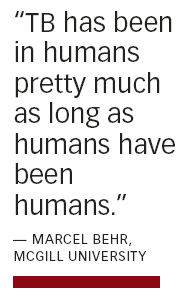Dangerous History
The genetic secrets of a savvy killer
Throughout recorded time, tuberculosis has wrought death among the people infected and frustration among those trying to tame it. As recently as the 1950s, prescribed treatment included little more than rest, sunlight, and fresh air. Today, patients take powerful drug cocktails for months. Even so, tuberculosis kills more people each year than any infectious disease other than AIDS.




And it is still unclear exactly how Mycobacterium tuberculosis, the bacterium that causes tuberculosis (TB) in people, does its damage. Other mysteries include why only some people get sick after being infected and why some outbreaks have managed so effectively to dodge vaccines and to resist antibiotic treatment.
In recent years, DNA analyses and fossil finds have revealed a surprising diversity in the genetic makeup of M. tuberculosis. Among its 4,000 genes, small but important differences appear to separate thousands of M. tuberculosis strains into distinct families, each with its own pattern of infection. A scientific community that long assumed TB had one genetic profile is now adapting to the idea that tens of thousands of years of evolution have sustained a pathogen that foiled human defenses by constantly changing.
As researchers piece together the M. tuberculosis family tree, they are finding tantalizing clues about why the pathogen has been so hard to get rid of and why new and virulent strains have repeatedly appeared in various places throughout history and are still showing up in Africa, Eastern Europe, and Asia today. The new information may eventually lead to better vaccines and treatments that target individual strains.
“It’s been the default assumption for years that it’s not really worth looking at the differences [among M. tuberculosis strains] because those differences must be so small,” says David Sherman, a molecular geneticist at the Seattle Biomedical Research Institute. “It has become clear in the very recent past that there are differences that are clearly relevant, and we are only just scratching the surface” in understanding what those differences mean.
One-third of the world’s population has TB, and a new person becomes infected every second, according to the World Health Organization. Most of those people show no symptoms of the disease until their immune systems become compromised by infection with the AIDS virus (HIV), by age, or by other factors.
When it does become active, TB usually strikes the lungs, though it can affect other organs such as the kidneys, liver, and bones. Nearly 2 million people die of the disease annually, and the death rate shows no sign of slowing. Many of those deaths are the work of new strains that resist most anti-TB drugs.
As the death toll continues to mount, scientists are scouring M. tuberculosis for weak spots. The work has been slow going, however, mostly because the bacterium takes its time, says Richard Chaisson, director of the Johns Hopkins Center for Tuberculosis Research Laboratory in Baltimore. Infectious bacteria such as Escherichia coli and Streptococcus species grow quickly in the lab and respond in minutes to tests with antibiotics or other drugs. But M. tuberculosis takes 24 hours to replicate, making lab experiments frustratingly slow. A trial of a new drug in animals, can take a year to complete because it takes that long to know whether all the bacteria in a given animal have been destroyed.
The bacterium is likewise hard to eradicate from an infected person, Chaisson says. A patient must take at least four drugs, for a period of 6 months or more. And if the patient stops treatment too soon, an all-too-common occurrence in developing countries, bacteria that develop drug resistance can survive.
Diversity lurks
For years, most TB research rested on the assumption that all cases of M. tuberculosis were the same, because the DNA sequences of different strains of the bacterium show much less diversity than the genomes of other bacteria do. In the early 1990s, however, scientists using new genetic-analysis techniques found previously unsuspected distinctions among M. tuberculosis strains. In particular, they discovered a DNA sequence called IS6110 that appears anywhere from zero to hundreds of times in a given bacterium. The number and location of repeats can be used to characterize the numerous M. tuberculosis strains that exist around the world, says Anne Stone, an anthropological geneticist at Arizona State University in Tempe.
Scientists have used the IS6110 marker to track outbreaks of individual strains, says Sebastien Gagneux, a molecular microbiologist at the Institute for Systems Biology in Seattle. A strain that has lain dormant in someone’s body for 20 years and only recently caused an infection, for example, might show one pattern of IS6110 repeats, while a more recently evolved and spreading strain might show another. Such information can help investigators understand how different strains spread among different groups of people, perhaps in ways related to their lifestyles. That knowledge can in turn shed light on which medical and public health interventions might be most effective.
Researchers also noticed that certain strains of M. tuberculosis appeared more often in certain parts of the world than in others. Similarities in the pattern of IS6110 repeats can easily arise by chance, however, because this genetic element mutates rapidly and inserts itself into the same gene regions of different strains, Gagneux says. That makes IS6110 a poor marker to use in studies of the evolution and distribution of strains.
To get a more accurate picture, Gagneux’s team has begun comparing the DNA of different M. tuberculosis specimens by looking for places where genes have disappeared. M. tuberculosis loses genes at a relatively slow and predictable rate, and once gone, genes rarely reappear. Deletions therefore provide reliable information about strains’ ancestries. Using a set of roughly 4,000 genes from a fully sequenced strain of M. tuberculosis as a reference genome, Gagneux’s team catalogued deletions in 875 strains from 80 countries.
The 875 strains fell into six distinct families that largely followed geographic lines. Two families are West-African, and the others are East-African-Indian, East-Asian, Euro-American, and Indo-Oceanic, the team reported in the Feb. 21, 2006 Proceedings of the National Academy of Sciences.
The discovery that all strains fit into six families shows how previous attempts to understand TB diversity have been misdirected. The first two strains of M. tuberculosis sequenced, for example, both turned out to belong to the same family. “It’s like looking at two bumps on a hill in Tennessee,” Sherman says, quoting a colleague. “There’s a whole world out there we completely ignored.”
Future vaccine and drug studies might include one strain from each family to see how each reacts to treatment, Gagneux says. “Now that we know there are six main groups distributed around the world, we have to find out whether we need six or more vaccines, or whether we can live with just one,” he says. “Ten years ago, people would laugh at you if you even mentioned this possibility” that different vaccines might be required to fight different versions of TB.
A better vaccine
Better, if not more, vaccines would be welcome. Today’s only TB vaccine, BCG (bacille Calmette-Guérin), was originally derived in the early 1900s from Mycobacterium bovis, a strain of TB that occurs mostly in cows but can also infect people. The vaccine is given to some 100 million infants each year, mostly in developing countries. It’s supposed to defend people against infection by presenting the immune system with a weakened version of an infectious bacterium.
But BCG doesn’t work very well. To the vaccine’s credit, although for reasons that aren’t clear, it seems to do a good job at preventing tuberculosis meningitis—an infection by M. tuberculosis of the membranes that surround the brain and spinal cord—which can be deadly for children. In preventing other forms of tuberculosis, however, the report on BCG is mixed.
In 1994, researchers at the Harvard School of Public Health analyzed several trials conducted over the previous few decades, and found that the vaccine had less than a 70 percent success rate at preventing TB. In some cases, in fact, people who got the vaccine were slightly more likely to get TB than were those skipping vaccination, Sherman says.
A closer look at the vaccine’s genome is providing insights into its ineffectiveness. That research is also shedding light on the virulence of some strains of TB. For instance, scientists have known for a decade that all BCG strains lack a nine-gene block of DNA called RD1. Since 2002, several studies have suggested that losing RD1 makes M. tuberculosis less virulent—which is probably why BCG is a safe vaccine. “From there,” Sherman says, “the race was on to figure out what those genes did.”
Researchers now have evidence that RD1 controls the production of three proteins that help the bacteria inject toxic lipids into the cells of their hosts. BCG strains without RD1 therefore can’t infect cells. Scientists are zeroing in on these critical genes as potential targets for treatment of virulent M. tuberculosis strains.
Genetic changes in BCG may also help explain why it has become still less effective over the years, and more ineffective in some places than others. The vaccine has been kept alive in different conditions at many labs around the world, so that each culture has evolved independently. Some strains may have lost certain virulent genes along the way, and vaccine makers have cultivated strains that cause less soreness after injection, which may have selected out certain genes.
Researchers from the Pasteur Institute in Paris recently found that, compared with earlier strains, vaccine strains produced after 1925 had accumulated a variety of mutations that might make them less effective. The genetic analyses, which appear in the March 27 Proceedings of the National Academy of Sciences, further support the idea that evolution during years of growth in the lab has steadily weakened BCG.
Exactly how genetic changes are linked to the vaccine’s performance is now “the million-dollar question,” says Marcel Behr, a bacterial genomicist at McGill University in Montreal. “We know the vaccine is imperfect, and we know it evolved. We don’t know to what extent evolution is responsible for its imperfection.”
Looking back
While some researchers are using TB genetics to look toward the future, others are reconsidering the disease’s past. For decades, genetic studies have been based on the assumption that people first caught TB from cows, starting when Europeans domesticated the animals about 10,000 years ago and began drinking their milk. In 1492, this theory held, Europeans brought TB to the Americas, where M. tuberculosis caused widespread epidemics. Recent studies, however, suggest that both these assumptions are wrong.
The 1994 discovery of M. tuberculosis DNA in the lungs of a 1,000-year-old mummified woman in southern Peru was one clue that people were suffering from TB long before Christopher Columbus—or cows—sailed to the New World, says Arizona State’s Stone.
In the past 4 years, several teams of scientists working with a variety of new genomic information have created a broadly consistent family tree for M. tuberculosis. Because TB loses genes as it evolves, and because M. bovis has fewer genes than the human form does, the tree unequivocally shows cows catching the disease from people.
By comparing genomes of M. tuberculosis strains taken from people in Europe and Africa, Cristina Gutierrez and her colleagues at the Pasteur Institute found evidence that all modern strains have evolved from a strain that still exists in East Africa. That strain, the scientists estimate, first appeared 3 million years ago. Their results appeared in the September 2005 PLoS Pathogens. Only Africa has endemic M. tuberculosis strains in all six families, Gagneux says, and two of those families occur nowhere else.
“The most plausible theory is that TB has been in humans pretty much as long as humans have been humans,” Behr says, “and the bacteria had an out-of-Africa migration with its host.”
It now seems possible that the first inhabitants of the Americas already lived with an African family of M. tuberculosis but could not fight off the more virulent Euro-American strain that came across the Atlantic in the 15th and 16th centuries. Anecdotal evidence suggests that the Euro-American family is now outcompeting African strains in Africa, Gagneux says.
The best explanation for these patterns, Stone says, is that M. tuberculosis has been evolving to infect people as people have evolved to fight it. “It’s an arms race,” she says, between the human immune system and TB.
Moving forward
These windows into the past are giving scientists a better sense of which TB-bacteria genes deserve a closer look. Genes that have been lost in some strains were obviously dispensable, Behr says, while genes that are in all modern strains probably are important. Scientists have noticed, for example, that M. bovis makes large amounts of two proteins called MPB70 and MPB83, which fire up the immune systems of their hosts, whereas M. tuberculosis makes lesser amounts.
If the old theory—that human TB descended from bovine TB—were true, it would seem that evolutionary changes must have dampened the production of these two proteins. That would in turn suggest that the MPB70 and MPB83 genes aren’t important in infecting people and would not make good candidates for attention from drug makers.
But with the order of evolution flipped, it now seems these genes’ activities grew as M. tuberculosis evolved, and that they might be important subjects for research.
“Having the sequence backwards blinded us,” Behr says. “It’s a Copernicus thing. If you think the sun is turning around the Earth, you get everything mixed up.”
An accurate TB family tree might also help scientists figure out what is behind the extra virulence of certain M. tuberculosis strains. As an example, Stone points to a deletion called TbD1 that appears in modern strains but not in ancient ones. Many strains causing recent epidemics have the deletion.
Scientists have also been finding mutations in drug-resistant strains, such as the Beijing strain, which caused an outbreak in New York City in the 1990s, and XDR-TB, which has been spreading ferociously through South Africa. Some mutations are common. Others are unique to individual strains or families.
As some researchers zero in on the genetic peculiarities of individual M. tuberculosis strains, others are working to sequence strains from all six of the worldwide families. In the genetic details, there may be pockets of vulnerability that will help scientists finally take down an ancient and stubborn killer.







